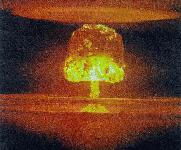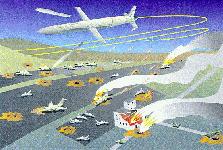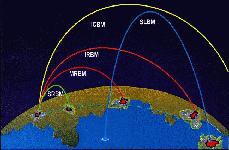
[Back]

[Index]

[Next]
National Air Intelligence Center NAIC-1031-0985-98
 [Back] |
 [Index] |
 [Next] |
Ballistic and Cruise Missile Threat National Air Intelligence Center NAIC-1031-0985-98 |

The Threat
Ballistic and cruise missiles present a significant threat to US and allied forces overseas, as well as to the United States and its territories. Missiles are attractive to many nations because they can be used effectively against an adversary with a formidable air defense system, where an attack with manned aircraft would be impractical or too costly. Missiles also have the advantage of fewer maintenance, training, and logistic requirements than manned aircraft. Even limited use of these weapons could be devastating, since missiles can be armed with chemical, biological, or nuclear warheads. The US Air Force, in cooperation with the other services, is responsible for countering the ballistic and cruise missile threat through deterrence and, if necessary, active suppression. Threat suppression may include attacks on missile systems, both before launch and in flight, as well as attacks on their supporting infrastructure. This document includes information on some of the major current and projected ballistic and cruise missile threat systems.Guided cruise and ballistic missiles were first used when Germany attacked targets in England and Northern Europe with V 1 cruise missiles and V-2 ballistic missiles during World War II. Although these missiles were inaccurate, their use resulted in tens of thousands of Allied casualties. The ballistic and cruise missile threat continues to increase with the proliferation of missile technology. Over 25 countries have ballistic missile systems, and it is likely that missiles will be a threat in future conflicts involving US forces. Ballistic missiles have been used in several recent conflicts, including the Iran-Iraq War, the Afghan Civil War, the war in Yemen, and the 1991 Persian Gulf War. Although land-attack cruise missiles have not yet been widely proliferated, many countries are expected to possess cruise missiles in the next decade. 

Warheads and Targets
Ballistic and cruise missiles can be armed with conventional or nonconventional warheads. Conventional warheads are filled with a chemical explosive, such as TNT, and rely on the detonation of the explosive and the resulting metal casing fragmentation as kill mechanisms. Nonconventional warheads include weapons of mass destruction (nuclear, biological, and chemical weapons), as well as nonlethal warheads, a relatively new class of warhead designed to disable equipment rather than harm personnel. Conventional, biological, and chemical weapons can be packaged in unitary (single) warheads and in submunitions (multiple small bomblets) that are released at altitude to disperse over a wide area. Conventional warheads can be optimized for specific types of targets. For example, submunitions can be used to create craters in an aircraft runway or destroy armored vehicles. A penetrator warhead, which uses a relatively small amount of explosive surrounded by a heavy metal casing, can pass through a hardened structure such as a bunker to destroy its contents. Almost all of the longer range ballistic missiles, and several types of land-attack cruise missiles, carry nuclear warheads. Most of these warheads have an explosive force that is tens to hundreds of times more powerful than the atomic bomb dropped on Hiroshima during World War II. Chemical and biological weapons are attractive to many Third World countries because they are much easier to produce than nuclear weapons. Unfortunately, many countries with chemical and biological warfare programs also are equipped with ballistic and/or cruise missiles. Accuracy is not very important for these weapons when used against urban areas or large concentrations of military forces. Chemical and biological weapons are capable of producing massive casualties, inducing panic and chaos in civilian populations, and severely degrading military operations.


Ballistic Missile Characteristics
In many short-range ballistic missiles, the entire missile remains intact until the warhead detonates. In longer range ballistic missiles, warheads are contained in separating reentry vehicles. Some long-range ballistic missiles carry multiple independently targetable reentry vehicles (MIRVs), with up to l0 reentry vehicles (RVs) per missile. RVs reenter the Earth's atmosphere at very high velocities, on the order of 4-5 miles per second at ICBM ranges. Ballistic missiles can use solid- or liquid- propellant rocket propulsion systems. The trend in modern missile systems has been toward the use of solid propellants because of their reduced logistical requirements and simplicity of operation. However, some Third World nations have greater access to liquid- propellant technology and therefore continue to develop new liquid-propellant missiles.
Operational ballistic missiles are deployed in silos, on submarines, and on land-mobile launchers, including trucks and railcars. Mobile missiles are favored by many nations because they can be hidden, which greatly increases their survivability.
Multiple-stage missiles, with each stage having its own independent propulsion system, are more efficient for longer range missions. ICBMs typically have two or three stages, with powerful liquid-propellant engines or solid-propellant motors to propel the payload toward its target, in addition to a post-boost vehicle (PBV) with a much smaller propulsion system. A post-boost vehicle can be used to improve the RV deployment accuracy for a single-RV missile. For a missile with a MIRV payload, the PBV is used to release reentry vehicles so that they follow different trajectories, allowing them to hit targets that may be separated by over a thousand miles. A high-quality inertial guidance system is capable of placing a reentry vehicle within a few hundred feet of the target after a flight of over 6,000 miles. Many of the missiles in use today, particularly among Third World nations, use relatively unsophisticated guidance systems that are only capable of delivering a reentry vehicle (or missile with a nonseparating warhead) within a half mile to a mile of a target after a flight of only a few hundred miles. However, this is still accurate enough to inflict massive casualties if the missile is armed with a weapon of mass destruction. As more modern guidance system technology is proliferated, countries will be able to improve the accuracy and lethality of their missile forces. Many ballistic missiles carry penetration aids to improve the chances of a reentry vehicle penetrating a ballistic missile defense system. Penetration aids are devices that attempt to deceive or jam sensors used to detect and track missiles and RVs. Penetration aids are of increasing importance to countries operating ballistic missiles. 
Ballistic Missile Category Maximum Range Short-range ballistic missile (SRBM) <1,000 km (621 mi) Medium-range ballistic missile (MRBM) 1,000-3,000 km (621-1,864 mi) Intermediate-range ballistic missile (IRBM) 3,000-5,500 km (1,864-3,418 mi) Intercontinental ballistic missile (ICBM) >5,500 km (3,418 mi) Submarine-launched ballistic missile (SLBM) Any ballistic missile launched from a submarine regardless of maximum range
 [Back] |
 [Index] |
 [Next] |
Ballistic and Cruise Missile Threat National Air Intelligence Center NAIC-1031-0985-98 |